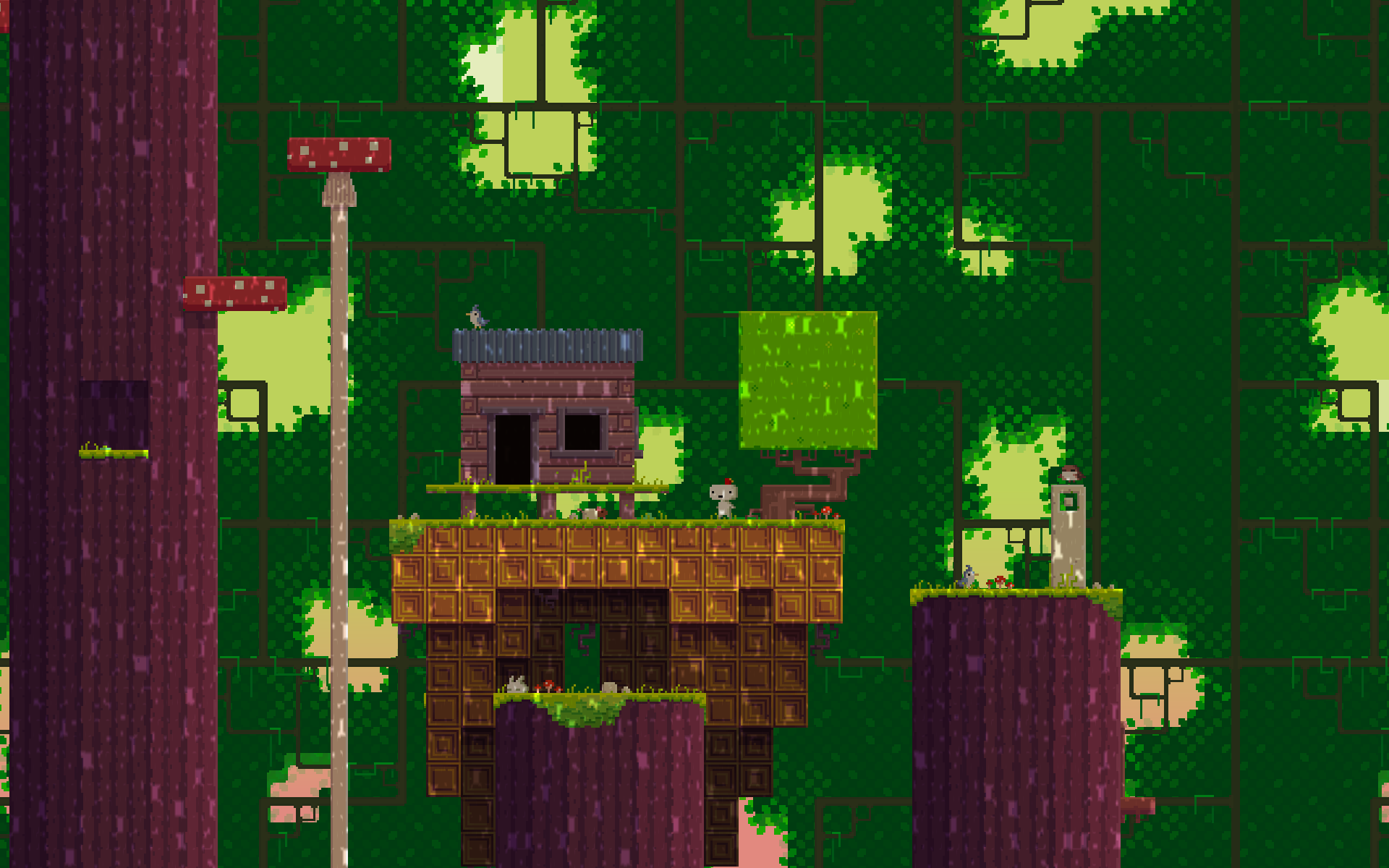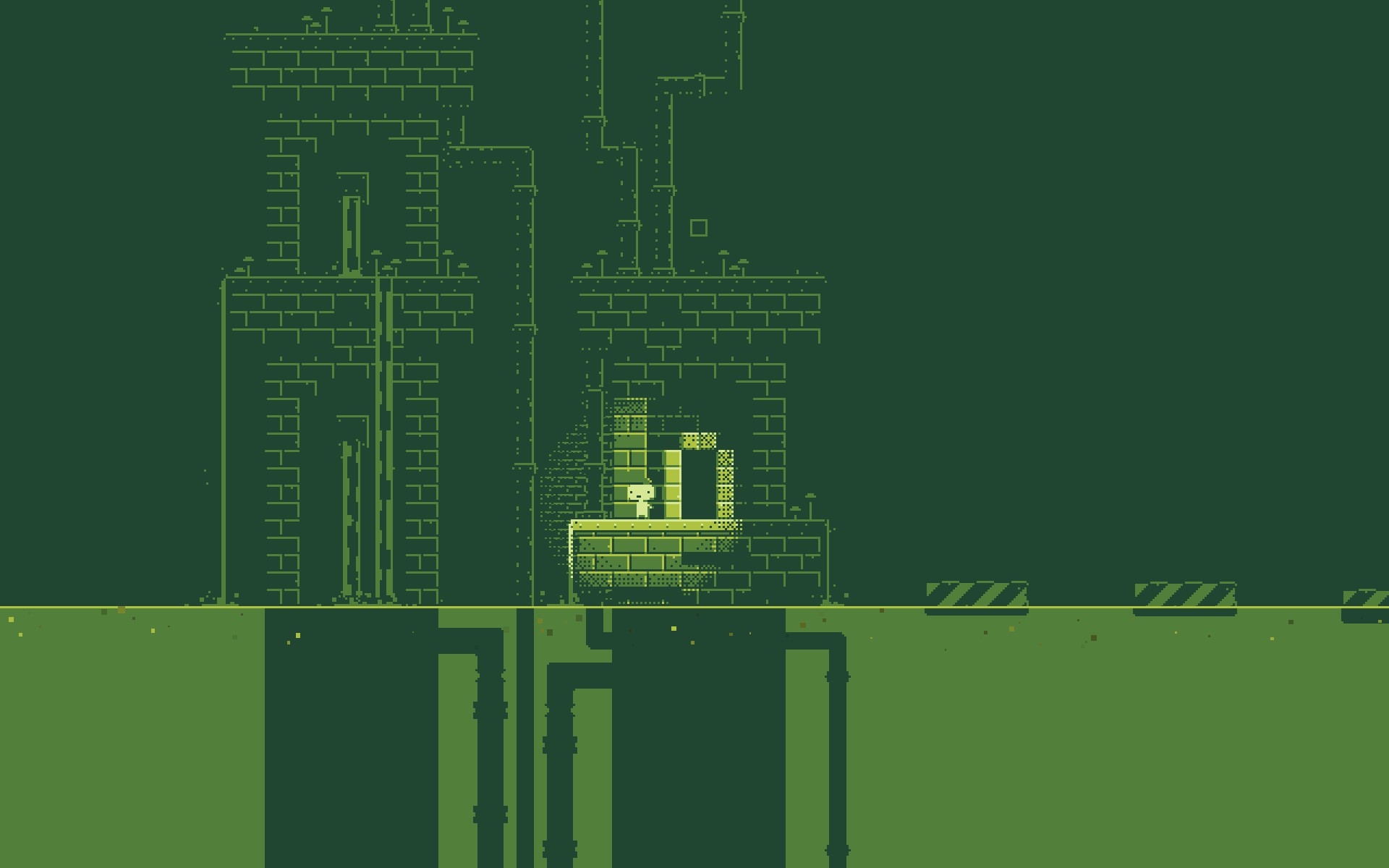Fez
Great Expectations
Fez is the kind of game with enough background to fill a review before gameplay has even been touched on. Whether it’s the life and times of designer Phil Fish, the hype which surrounded the game’s development for almost five years, or its appearance in celebrated documentary Indie Game: The Movie, there’s no shortage of material here. Few games have a wikipedia article dedicated just to their development, after all.
However, setting all of that aside, it should be obvious even from a cursory glance at screenshots or gameplay footage, that this game is something special. And this is a game review, so without further ado, let’s focus on what Fez is as a game and whether or not you might like to play it.
A change of perspective

Aside from the colourful pixel graphics and chirpy chiptune soundtrack, the first impression Fez makes is all about its key mechanic, a glorious reinvention of 2d platforming, with a 3d spin. Of course, most gaming takes place on a 2d screen, whether a game itself is trying to simulate a 3d world or not. And at its heart, Fez does remain a 2d game, with many familiar platforming mechanics — some so familiar that they (consciously) drift into homage. But the trick here is how a 3d environment is mapped onto a 2d screen, how different perspectives must be explored to reveal the full picture.
In straightforward terms, Fez is much like any other 2d platformer, just presented from four viewing angles. As the player, you can rotate the scene 90 degrees at a time. Each time you rotate, you’ll see the same objects, as viewed from a different ‘side’.
You might see new objects, revealed from the new perspective, including doors to previously hidden areas. Or an individual platform might be narrow when observed from one side, then grow much wider, and more accessible, when rotated. So a jump that was far too long in one view becomes trivial when rotated: the landscape is constantly malleable.
In gameplay terms, the challenge becomes working out how this world translates from 3d into 2d, and back again.
Each mind perceives a different beauty
Fez is a gorgeous game to look at. The incredible attention to detail led me, from time-to-time, to just sit back and drink it all in. The pixel-art on show is simply stunning, probably the best realisation of a much-used style that I’ve seen in a game. It’s not just attractive in its own right, it perfectly reflects the setting too.

Animals ranging from seagulls to worms constantly roam the playing space, not really serving any other purpose than to bring life, to make the experience that much more interesting.
Variations on the core aesthetic are handled with such care that, although they present the game in a totally different style, it never seems out of place. Fez is always recognisable as Fez.
And none of this detracts from how the game plays. All too often, games suffer when there’s a lot going on by making things ambiguous, resulting in a guessing game as to what’s foreground, and interactive, and what isn’t. Fez just never really suffers from this issue.
Oh the places you’ll go
The overall aim of the game revolves around collecting ‘cube shards’ — the details aren’t really important, but these collectibles are scattered around a large map, full of hidden pathways, unlockable doors, and secret areas. Thankfully, the map clearly indicates when secrets remain to be discovered.
Fez is a forgiving game, along the lines of Celeste when it comes to not outright killing the player. When you die, you respawn immediately, very often in exactly the same location. It’s usually slightly more nuanced than that, so you cannot actually gain an advantage by taking unconsidered risks, but it means you won’t ever really lose progress.

The difficulty here isn’t about pixel-perfect precision or how to execute a tricky combination of actions to get a particular jump just right. You’re asked to think (differently!) and find your way around, hence Fez is very much a puzzle platformer.
I wouldn’t call it a metroidvania, as such — there aren’t really abilities to gain, beyond the initial core mechanic which is introduced at the start. But there are moments where paths are blocked until other progress is made, and there’s a lot of backtracking involved, which conveys a similar feel.
Well, nobody’s perfect
It’s possibly inevitable that such a unique mechanic suffers from the implementation. Fez does a perfectly decent job solving some of the challenges: the ability to ‘walk out’ from behind an object that you’ve just rotated in front of the main character can only really be appreciated through play. Similarly, the decision to be ‘forgiving’ when it comes to player death was an excellent one; even when frustrations creep in, it’s hard to get too worked up about losing mere seconds of progress.
However, by its very nature, Fez has some shortcomings. First off, it’s very easy to fall off a platform when rotating, occasionally counterintuitively. It’s also difficult to tell when certain jumps are impossible because they are simply designed to be, or if they are possible only when the rotation is correct. Should I ever be required to rotate in midair to make a jump? It’s possible, but very fiddly, so I was left feeling uncertain as to whether that approach was correct or not.
Overall, the controls are complex, to say the least. Few platformers make quite so much use of the keyboard: not only are there standard controls to move, in addition to those that rotate the camera, there are also two or three different ‘action’ keys and four different keys to pan in all directions. I rarely used the panning action, but it’s still there, cognitively loading me up.
The world map is another good example of what is wrong with this game. It’s an amazing feat of engineering, and the end effect will blow your mind once you realise how to use the damn thing, but that’s the problem: it’s not easy to use. It’s probably the clearest example of the ‘style over substance’ problem that Fez can suffer from.

Beyond these issues, the few complaints I have are minor: the weird ‘glitch holes’ that appear at some points aren’t well explained, the ‘tetris puzzles’ are awkward and fiddly to execute. It feels like this is a rare occasion where a game has too much going on rather than too little.
Verdict
🤩
Ultimately, although it’s a crowning achievement, and a spectacular piece of work, I feel Fez lets me down ever-so-slightly on gameplay. Maybe that’s unfair — because it’s still a genuinely great game — but it could be that it sets its own bar impossibly high.
On occasion, it feels like there’s just too much crammed into one experience: is there really room for the main mechanic and the secret symbolic language and the in-joke ‘bugs’ / ‘game crashes’ all at-once? It’s enough of a sensory overload dealing with what makes Fez a joy to play, without some of these added extras.
As an experience, it’s movingly original. As a game, it’s very good, but somehow leaves me underwhelmed.
But, still, Fez is a great game. It’s a unique game, a game full of imagination. A beautiful game, in several senses of the word.
I played Fez on Mac for 10 hours. I finished the main game, with 8/12 achievements and 100.8% completion. Apparently, that’s out of a huge 209.4%, so there’s a lot more to this game and I’m relishing the thought of returning to it one day.
I paid £2.79 for Fez, which was a large discount on the standard £6.99 price. Even at full price, though, it’s an absolute bargain.
Fez was designed by Phil Fish, programmed by Renaud Bédard, and published by Trapdoor.